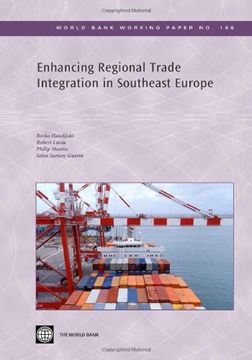Share
Enhancing Regional Trade Integration in Southeast Europe (World Bank Working Papers)
Borko Handjiski; Robert Lucas; Philip Martin (Author)
·
World Bank Publications
· Paperback
Enhancing Regional Trade Integration in Southeast Europe (World Bank Working Papers) - Borko Handjiski; Robert Lucas; Philip Martin
Choose the list to add your product or create one New List
✓ Product added successfully to the Wishlist.
Go to My Wishlists
Origin: U.S.A.
(Import costs included in the price)
It will be shipped from our warehouse between
Monday, May 27 and
Wednesday, June 12.
You will receive it anywhere in United Kingdom between 1 and 3 business days after shipment.
Synopsis "Enhancing Regional Trade Integration in Southeast Europe (World Bank Working Papers)"
The Southeast Europe (SEE) region comprises a group of countries with a common objective, and prospect, to become members of the European Union (EU). To achieve the goal of EU membership, these countries have pursued closer integration with the EU as well as with each other. In December 2006, the SEE countries, and Moldova, signed the Central European Free Trade Agreement (CEFTA), a comprehensive free trade agreement that aims to fully liberalize trade in the region as well as to achieve greater cooperation in a number of trade-related areas. This book is part of the World Bank's efforts to understand the impact of CEFTA on regional trade flows, as well as to put forward other, complementary, ideas that could enhance further regional trade integration. The first study looks at intra-regional trade flows and the remaining non-tariff barriers to trade in the region. The second study assesses the costs and benefits of allow free movement of skilled labor within the region, and the last study looks at how adopting the EU's Common External Tariff could prevent trade diversion. Intra-regional trade has increased rapidly in recent years, however, the content of trade flows do not signal significant trade integration, similar to what the countries of Central and Eastern Europe achieved in the past decade. Following the tariff liberalization, non-tariff barriers have become the main obstacles for trade. Enhanced regional trade integration should not be confined only to free movement of goods. Increased labor mobility could also have trade creation effects and help create a more integrated regional market. Finally, tariff structures in many countries of the region allow some scope for trade diversion in favor of EU and CEFTA countries at the expense of the rest of the world. Such trade diversion could be reduced by adopting EU's Common External Tariff structure.
- 0% (0)
- 0% (0)
- 0% (0)
- 0% (0)
- 0% (0)
All books in our catalog are Original.
The book is written in English.
The binding of this edition is Paperback.
✓ Producto agregado correctamente al carro, Ir a Pagar.

